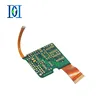7 Layer Rigid-flex PCB Assembly by Leadsintec
Name: 7 Layer Rigid-flex PCB Assembly by Leadsintec
Origin: china
Certified: UL, CE, RoHS
Surface finish: ENIG/HASL/immersion Tin/ immersion Silver/ Hard Gold
Material: Shengyi/ Panasonic/ Durpont/TEQ/TAIFlex
Solder mask :green, blue, white, red, etc
Board thickness: customized
What is 7 Layer Rigid-flex PCB Assembly?
A form of printed circuit board (PCB) known as a 7-layer rigid-flex PCB assembly combines stiff and flexible circuitry in a multi-layered design. It has seven layers, wedged together in an alternating pattern of stiff and flexible layers.
- Electronic devices that require both flexibility and structural stability often employ rigid-flex PCBs. While the flexible elements enable the board to bend or mould to fit into awkward shapes or small places, the stiff components of the board offer support and stability.
- Typically, layers of a 7 layer rigid-flex assembly are constructed of woven fiberglass. This fiberglass is covered in a thick coating of epoxy resin. Materials made of polyimide are used for their flexibility. It is sturdy and resilient to motion and stress. Polyester makes the electrical connections between components and various board regions possible.
The beneficial properties of a 7-Layer Rigid-Flex PCB Assembly:
Compact and space-saving designs:
Comparing the 7 layer rigid-flex PCB assembly to other PCB designs, it has several advantages. Compact and space-saving designs are made possible by rigid-flex PCBs, which combine the benefits of stiff boards and flexible circuitry. The numerous layers for applications with limited space make it possible to incorporate more components into a smaller space.
Increased dependability:
Due to their resistance to mechanical stress, shock, and vibration, rigid-flex PCBs offer increased dependability. Due to the reduced likelihood of component failure brought on by movement or physical stress and the mix of stiff and flexible portions, they are appropriate for demanding situations.
Offers greater design freedom:
A seven-layer rigid-flex PCB assembly combines stiff and flexible parts and offers greater design freedom. As a result of the flexible parts’ ability to bend and fold, the PCB can accommodate unusual forms and confined places, which is sometimes impossible with rigid boards alone. Complex connecting schemes may be implemented with a rigid-flex assembly utilizing fewer external connectors and cables. This lowers the need for extra parts and streamlines the assembly procedure, improving system performance and reliability.
Application of 7 Layer Rigid-flex PCB Assembly:
- Rigid-flex PCBs offer a broad range of applications in the medical field, including laser surgical equipment, medical MRI equipment, and x-ray treatment equipment.
- This is due to their great adaptability. Consumer electronics include wearable technology, imaging devices, VR and AR equipment, PCs, laptops, cellphones, TVs, tablets, game consoles, speakers, and headphones, which use rigid-flex PCBs.
- Numerous industrial control applications for rigid-flex PCB exist, including programmable controllers PLC, touch screens, industrial computers, contactors, thermal relays, inverters, etc. Military ships, ground armor, electronic data, the nuclear industry, and military aviation and aerospace equipment are only a few of the military uses for rigid-flex PCB.
- The use of rigid-flex PCB assemblies is a result of the desire for smaller and more adaptable consumer electrical products. They are found in portable game consoles, wearable technology, digital cameras, cellphones, and tablets.
- A variety of electronic systems are used in modern vehicles for control, entertainment, navigation, and safety. Automotive electronics, such as engine control units (ECUs), infotainment systems, advanced driver-assistance systems (ADAS), and lighting control modules, use 7-layer rigid-flex PCB assemblies.






